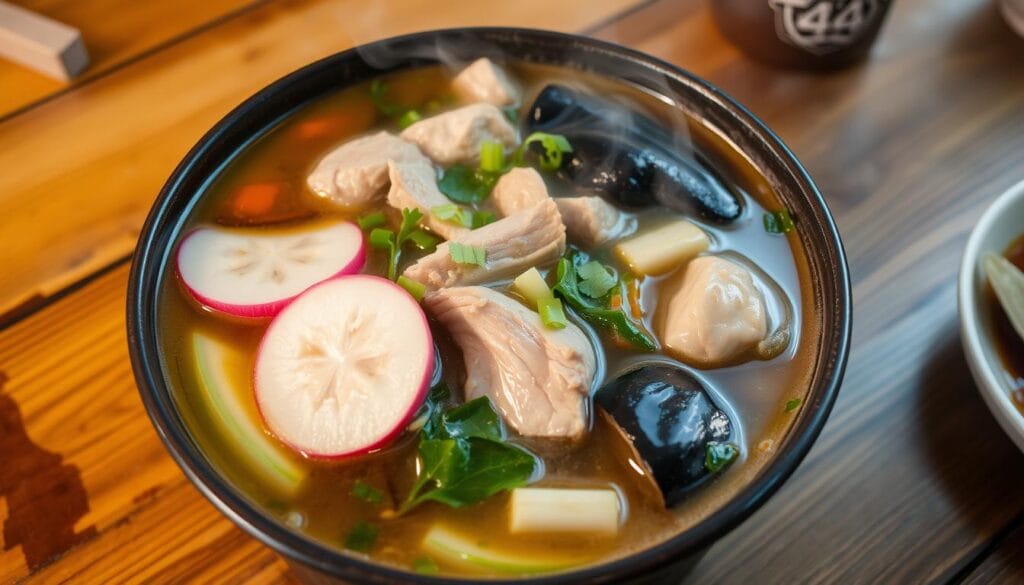Exploring Filipino cuisine, you’ll find sinigang is a heartwarming dish. It combines sour and savory flavors perfectly. This easy recipe is a must-try for authentic Philippines taste. You can find many sinigang recipes online, but a traditional Filipino one is best to start with.
Imagine a delicious bowl of sinigang, made with love. It’s like the ones found on Filipino sinigang recipe websites. Tamarind, vegetables, and proteins like pork or chicken make a unique flavor. It’s so good, you’ll want more.
Key Takeaways
- Sinigang is a traditional Filipino dish that is both sour and savory.
- A sinigang recipe typically includes tamarind, vegetables, and protein sources like pork or chicken.
- Cooking sinigang can be easy and fun, with a preparation time of just 15 minutes and a cooking time of 2 hours.
- Each serving of sinigang provides approximately 250 calories, 20g of protein, and 5g of fiber.
- Sinigang is a comfort food that is commonly eaten during rainy days or when feeling unwell, highlighting its emotional significance in Filipino culture.
- You can store sinigang in the refrigerator for up to 3 days or freeze it for up to 2 months.
Understanding the Soul of Filipino Sinigang
Sinigang is more than a dish; it’s a cultural experience. It has a rich history and many regional variations. The traditional sinigang recipe is loved in many Filipino homes. Its unique taste has won the hearts of many.
A Filipino sinigang recipe uses sour broth with tamarind, tomatoes, and veggies like green beans and eggplant. The sinigang na baboy recipe is famous for using pork. It’s a hearty dish with bold flavors, loved as a comfort food in the Philippines.
The Cultural Significance of Sinigang
Sinigang has a big role in Filipino culture. It brings people together, enjoyed at family gatherings and special events. Making sinigang is a labor of love, requiring patience and dedication.
Regional Variations Across the Philippines
Each region in the Philippines has its own sinigang style. From spicy to sour, sinigang shows the country’s rich cultural heritage. Its diverse ingredients and cooking methods reflect the Philippines’ cultural diversity.
Essential Ingredients for Authentic Sinigang
To make authentic sinigang, you need tamarind, veggies, and proteins like pork or chicken. The soup includes daikon radish, eggplants, and okra. You can add pork belly or shrimp for extra flavor.
The secret to great sinigang is the mix of sour and savory. Tamarind is key, but you can try guava or lemon too. For a quick recipe, use pre-made tamarind paste or broth. Sinigang na baboy and sinigang na hipon are tasty variations.
Here are the must-haves for your sinigang recipe:
- Tamarind or other souring agents
- Vegetables like daikon radish, eggplants, and okra
- Protein sources like pork, chicken, or shrimp
- Garlic, onion, and tomatoes for added flavor
- Fish sauce and salt to taste
With these ingredients and a simple recipe, you’ll make a delicious sinigang. It’s sure to impress your family and friends.
The Perfect Sinigang Recipe for Beginners
To make a delicious sinigang dish, follow a simple sinigang recipe. This traditional Filipino soup combines protein, vegetables, and a sour broth. An easy sinigang recipe lets you create a tasty and healthy meal for any time.
For how to cook sinigang, mix the right ingredients and cook slowly. Start by preparing the protein and vegetables. Then, cook them in a sour broth with tamarind and spices.
- Prepare the ingredients, including the protein and vegetables
- Cook the protein and vegetables in a sour broth made with tamarind and other spices
- Season the dish with fish sauce and other spices to taste
By following these steps and using an easy sinigang recipe, you can make a delicious sinigang dish. It’s perfect for any occasion. Whether you’re new or experienced, how to cook sinigang is fun and easy. The result is a flavorful and nutritious meal that everyone will love.
Mastering the Signature Sour Broth
To make a real sinigang soup, mastering the sour broth is key. Tamarind is the secret ingredient that gives it its special taste and smell. A great sour soup balances sour and savory, making it a joy to eat.
For a tamarind soup, you can use fresh or dried tamarind. Fresh tamarind tastes more vibrant, but dried is fine if fresh is hard to find. To get the broth, soak tamarind in hot water and then strain it.
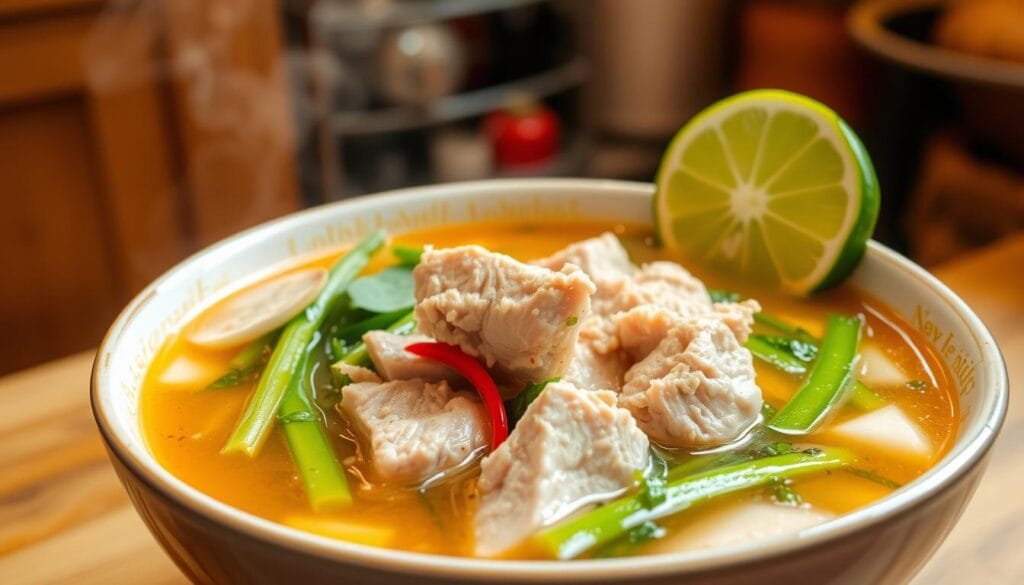
Here are tips for the perfect sour and savory mix in your sinigang soup:
* Use just the right amount of tamarind for the sourness you want.
* Mix the sourness with savory flavors like fish sauce and onions.
* Add veggies like tomatoes and okra for sweetness and texture.
| Ingredient | Quantity |
|---|---|
| Tamarind | 1 cup |
| Fish sauce | 2 tablespoons |
| Onions | 1 medium |
Follow these tips and use the right ingredients to make a tasty, authentic sinigang soup. It will highlight the signature sour broth perfectly.
Traditional Sinigang na Baboy (Pork Sinigang)
To make a tasty sinigang na baboy recipe, pick the right pork cut. Pork belly is a top choice, needing 2 lbs. for a standard recipe. For a traditional sinigang recipe, pork spare ribs work well, cooking for about 30 minutes to get tender.
Here’s how to cook a pork sinigang recipe:
- Get your ingredients ready, including 2 pounds of pork spare ribs, 8 cups of water, and 15 pieces of fresh tamarind or 1.5 packages of tamarind powder.
- Cook the pork until it’s tender. Then, add the tamarind and other veggies like taro root, daikon radish, and long beans.
- Let it simmer for 15 minutes after adding fish sauce. Season with salt and pepper to taste.
Follow these easy steps to make a delicious and authentic sinigang na baboy recipe. This traditional sinigang recipe is a classic Filipino dish that will be a hit in your home.
Hearty Sinigang na Baka (Beef Sinigang)
A sinigang na baka recipe is a hearty Filipino dish. It’s made with beef, veggies, and tamarind. This beef sinigang recipe is a twist on the classic sinigang, loved by many.
To make this tasty traditional sinigang recipe, you’ll need beef short ribs, water or broth, potatoes, and veggies like pechay and kangkong leaves. The beef takes 50 to 60 minutes to cook until tender. Potatoes and pechay cook in 7 to 10 minutes and 2 to 3 minutes, respectively.
Here’s a quick look at the sinigang na baka recipe‘s nutritional info:
| Nutrient | Amount per serving |
|---|---|
| Calories | 457 kcal |
| Carbohydrates | 30 g |
| Protein | 38 g |
| Fat | 21 g |
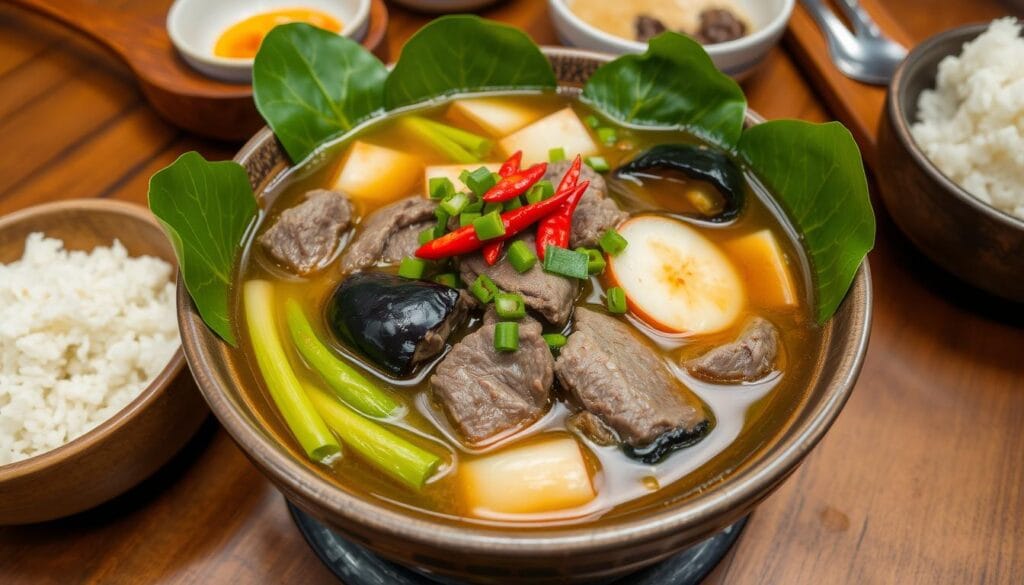
The beef sinigang recipe is a beloved twist on the classic. Its rich and tangy flavors make it a favorite in many homes. This sinigang na baka recipe is sure to win hearts with its unique taste.
Vegetable Components and Their Importance
Vegetables are key in a tasty sinigang recipe, just like protein and tamarind. You can pick from many vegetables to make a sinigang that you’ll love. Daikon radish, eggplants, long green peppers, string beans, tomatoes, okra, and water spinach are must-haves.
A sinigang with vegetables can be as tasty as one with meat. It’s perfect for those who don’t eat meat. Just mix different veggies and cook them until they’re tender. Daikon radish and eggplants need more time than okra and water spinach.
Here’s a list of cooking times for some common vegetables used in sinigang:
- Daikon radish: 10-15 minutes
- Eggplants: 8-12 minutes
- Long green peppers: 7-10 minutes
- String beans: 6-8 minutes
- Tomatoes: 5-7 minutes
- Okra: 5-7 minutes
- Water spinach: 3-5 minutes
Choosing the right veggies and cooking them right makes a great sinigang. Whether you want a classic or a veggie sinigang, use fresh ingredients for the best flavor.
Tamarind: The Key to Perfect Sourness
Tamarind is essential for the perfect sourness in sinigang. You can use fresh or packaged tamarind for a tasty tamarind soup. Boil tamarind in 2 quarts of water for 40 minutes to 1 hour to get the sourness right.
To balance the sourness, mix it with other flavors. Tamarind is great in many dishes, including sinigang. The sourness of tamarind changes with the fruit’s type and ripeness. Young tamarind, or sampaloc, has more tartaric acid, making it sourer.
Fresh vs. Packaged Tamarind
Fresh tamarind gives a more authentic taste, but it’s harder to use. Packaged tamarind is easier to find and use. Just follow the package instructions to get the right sourness in your sinigang.
Proper Souring Techniques
To get the sourness just right, use the right techniques. Boil tamarind in water to get the sour flavor. Then, strain it to remove the solids. Adding tomatoes and onions can also balance the flavor for a tasty sour soup.
Common Mistakes to Avoid When Cooking Sinigang
Learning to cook sinigang requires knowing common mistakes. Overcooking the protein and vegetables is a big one. It makes them tough and not tasty. To fix this, use a good sinigang recipe and adjust cooking times.
Not enough tamarind is another mistake. Tamarind is key for sinigang’s sour broth. Look for recipes that highlight tamarind. You can also play with tamarind amounts to get the right sourness.
Some common mistakes to avoid when cooking sinigang include:
- Overcooking the protein and vegetables
- Not using enough tamarind
- Under-seasoning the broth
- Adding vegetables too early, which can make them mushy
By avoiding these mistakes, you can make a tasty sinigang at home. Stick to a reliable recipe and tweak ingredients and times as you like. With practice, you’ll get better at making sinigang. Enjoy it with your loved ones.
Modern Twists on the Classic Sinigang Recipe
Exploring sinigang reveals a dish that has grown, adding new flavors and ingredients. Chefs and home cooks are now mixing things up, creating a modern twist on the classic sinigang. This results in a unique and exciting easy sinigang recipe.
A modern sinigang recipe can include different proteins like pork, shrimp, or beef. It can also feature a variety of vegetables, including tomatoes, okra, and bok choy. To enhance flavor, try using tamarind or calamansi as souring agents.
Fusion Variations
Modern sinigang now includes international flavors and ingredients. Adding Korean chili flakes can give it a spicy kick. Using Japanese miso paste adds depth and umami. These changes make sinigang a unique and delicious dish.
Healthy Adaptations
Many modern sinigang recipes focus on healthy ingredients. They use lean proteins like chicken or fish and add lots of vegetables. This makes sinigang a guilt-free option that’s both tasty and nutritious.
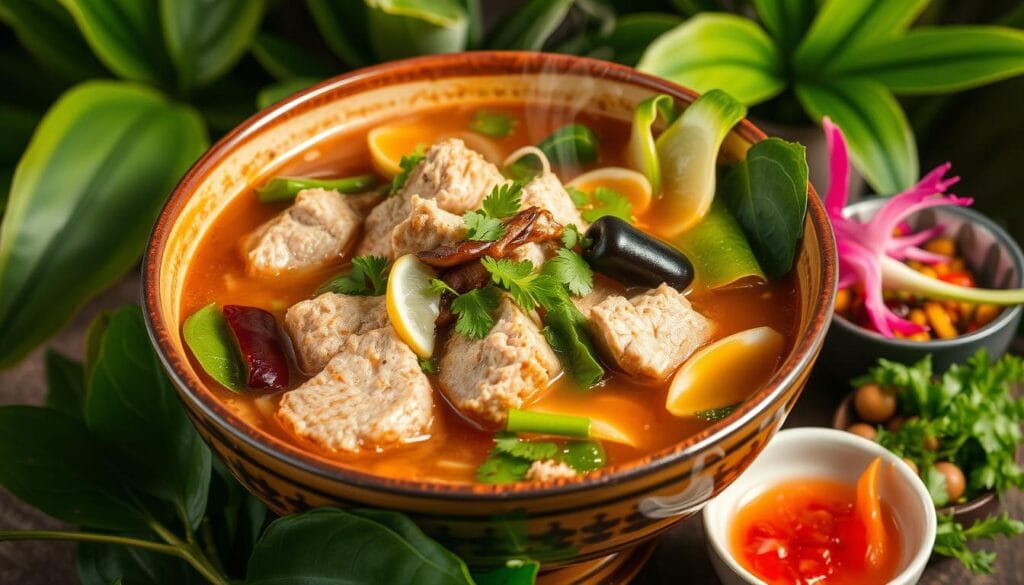
- Sinigang with grilled pork and pineapple
- Shrimp sinigang with spicy Korean chili flakes
- Vegetarian sinigang with tofu and mixed vegetables
These new takes on sinigang inspire you to experiment with flavors and ingredients. They help you create a unique sinigang recipe that highlights the best of Filipino cuisine.
| Modern Sinigang Recipe | Ingredients | Flavor Profile |
|---|---|---|
| Sinigang with Grilled Pork | Pork, pineapple, tomatoes, okra | Sweet and sour with a smoky flavor |
| Shrimp Sinigang with Spicy Korean Chili Flakes | Shrimp, Korean chili flakes, bok choy, tomatoes | Spicy and sour with a burst of umami flavor |
| Vegetarian Sinigang with Tofu | Tofu, mixed vegetables, tomatoes, spinach | Light and refreshing with a hint of sourness |
Serving and Presentation Tips
When serving sinigang, how it looks matters a lot. You want your easy sinigang recipe to impress your guests. Garnish it with fresh kangkong leaves or chili slices for a nice touch.
A beautifully presented sinigang can make the meal better. Here are some tips to help you:
- Use colorful veggies like eggplant, okra, and string beans to make it look good.
- Arrange the ingredients in a balanced way.
- Add green onions or a lemon slice for extra color.
Serving sinigang is about more than just the food. It’s about the experience. By focusing on presentation and using a tasty sinigang recipe, you’ll create a memorable meal. These tips are perfect for any occasion, from family gatherings to special events.
With these tips, your sinigang will be a hit. You’ll enjoy a delicious and beautiful meal with your family. So, try these tips and enjoy your favorite sinigang recipe like never before.
Storing and Reheating Your Sinigang
To keep your sinigang recipe tasting great, it’s key to store and reheat it right. Always use airtight containers to stop bacteria and spoilage.
Proper Storage Methods
Put your sinigang in the fridge within 2 hours of cooking. Keep it at or below 40°F (4°C). You can keep sinigang in the fridge for 3-4 days in airtight containers.
If you want to store it longer, freeze your sinigang. It can stay good for about 2-3 months.
Reheating Guidelines
When you reheat your easy sinigang recipe, make sure it reaches 165°F (74°C). This is to keep it safe to eat. You can reheat it on the stovetop or in the microwave.
But, don’t let it get too hot. This can mess up the texture and taste. By following these storing sinigang tips, you can enjoy your sinigang recipe for a longer time.
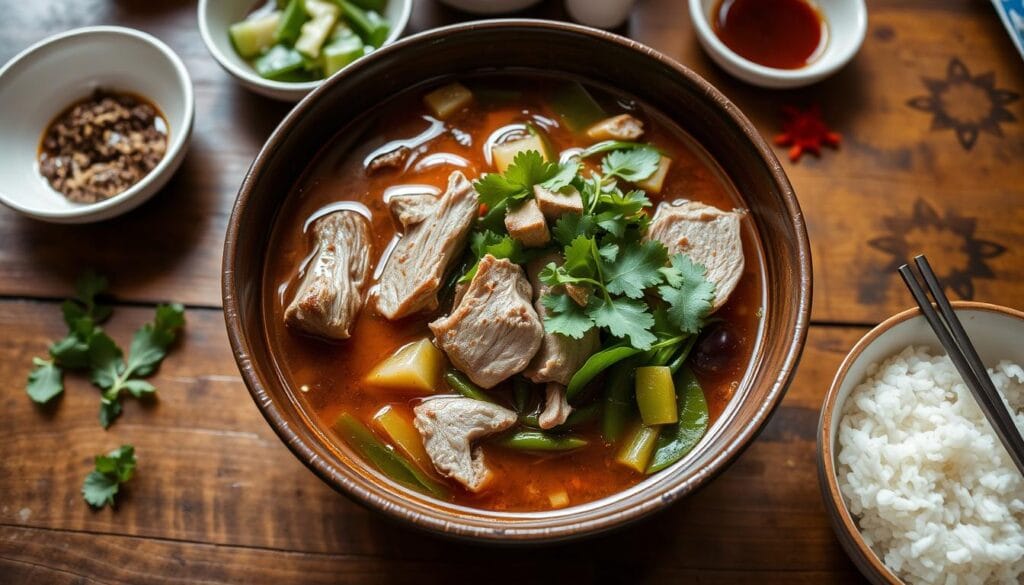
| Storage Method | Storage Duration |
|---|---|
| Refrigeration | 3-4 days |
| Freezing | 2-3 months |
Pairing Suggestions and Side Dishes
There are many ways to pair sinigang. You can choose from traditional and modern options. For a simple sinigang recipe, try it with steamed rice and grilled fish. This combo is a favorite in Filipino cuisine and is loved by many.
For a modern twist, pair sinigang with fried lumpia or roasted veggies. The goal is to balance the sourness of sinigang with the richness of the side dish. With an easy sinigang recipe, you can try different pairings to find your favorite. Here are some ideas:
- Freshly steamed rice
- Grilled fish
- Fried lumpia
- Roasted vegetables
When pairing sinigang, aim for a balance of flavors and textures. A little experimentation can lead to the perfect match. These suggestions will help you enjoy a complete meal with your sinigang, whether it’s simple or complex.
Looking for something traditional or modern? There’s a pairing for you. Be creative and find your favorite sinigang pairing. Sinigang’s unique flavors make it versatile, pairing well with many dishes and ingredients.
| Side Dish | Description |
|---|---|
| Steamed Rice | A classic pairing option that helps to balance the sourness of the sinigang |
| Grilled Fish | A protein-rich option that complements the flavors of the sinigang |
| Fried Lumpia | A crispy and savory option that adds texture to the meal |
| Roasted Vegetables | A healthy and flavorful option that adds depth to the meal |
Health Benefits of Sinigang Ingredients
When making a sinigang recipe, think about the health perks of each ingredient. A classic sinigang recipe includes veggies, proteins, and tamarind for sourness. These add flavor and health benefits, making sinigang a nutritious choice.
The veggies in sinigang, like eggplant and radishes, are full of vitamins A and C and fiber. Proteins like oxtail offer amino acids for muscles. Tamarind, the souring agent, is packed with antioxidants and fights inflammation.

- Rich in vitamins A and C
- Good source of dietary fiber
- High in antioxidants
- Provides essential amino acids for muscle growth and repair
In summary, a balanced sinigang recipe is both healthy and tasty. It’s a great pick for anyone wanting a nutritious meal.
Conclusion: Mastering Your Homemade Sinigang
Your journey to becoming a sinigang connoisseur has reached its final destination. You now have the skills to make delicious homemade sinigang anytime. You can try the classic sinigang na baboy (pork sinigang) or sinigang na hipon (shrimp sinigang).
Creating a perfect sinigang recipe means mastering the sour broth. Mix tamarind’s tartness with savory and umami flavors. This balance gives sinigang its unique taste. Feel free to adjust the sourness to your liking.
Keep improving your sinigang skills by trying new vegetables and proteins. This dish is very flexible, making it easy to create easy sinigang recipes for your family. Enjoy making and sharing your homemade sinigang with loved ones for years.
FAQ
What is Sinigang?
What are the different types of Sinigang?
What are the key ingredients in Sinigang?
How do you make the perfect Sinigang broth?
What are some common mistakes to avoid when cooking Sinigang?
How can I serve and present Sinigang?
What are the health benefits of Sinigang ingredients?
Source Links
- Sinigang na Baka (Filipino Sour Beef Soup) – Kusina Secrets – https://kusinasecrets.com/sinigang-na-baka-filipino-sour-beef-soup/
- Authentic Sinigang Recipe: Savory Filipino Tamarind Soup – Squeezy Recipes – https://squeezyrecipes.com/sinigang-recipe-filipino-tamarind-soup/
- Sinigang na Manok (Filipino Sour Chicken Soup) – Kusina Secrets – https://kusinasecrets.com/sinigang-na-manok-filipino-sour-chicken-soup/
- Simple VEGAN SINIGANG: So Yum! (all ingredients at regular store) – https://ricelifefoodie.com/vegan-sinigang-recipe/
- ALL Natural Sinigang Na Hipon Recipe: Shrimp Sinigang (Step By Step IMAGES!) – https://ricelifefoodie.com/natural-sinigang-na-hipon-recipe-shrimp-sinigang/
- How To Make Sinigang from Scratch – Jeanelleats Food and Travel Blog – https://jeanelleats.com/sinigang-recipe/
- Sinigang – https://panlasangpinoy.com/pork-sinigang-na-baboy-recipe/
- Pork Sinigang (Sinigang na Baboy) | Iankewks – https://iankewks.com/pork-sinigang-sinigang-na-baboy/
- Sinigang na Baboy (Pork Sinigang Recipe) – speedyrecipe.com – https://speedyrecipe.com/sinigang-na-baboy-pork-sinigang-recipe/
- Pork Sinigang Recipe – https://cooking.nytimes.com/recipes/1019216-pork-sinigang
- Master the Perfect Sinigang Recipe: A Filipino Classic Explained – https://www.coockcronicle.com/sinigang-recipe-filipino-sour-soup/
- Sinigang: The Ultimate Guide to Philippines’ Favorite Sour Soup – Festive Pinoy – https://festivepinoy.com/sinigang-the-ultimate-guide-to-philippines-favorite-sour-soup/
- Authentic BEST Natural Beef Sinigang Recipe – https://ricelifefoodie.com/beef-sinigang-recipe-filipino-sour-soup/
- Authentic Sinigang na Baboy – Kusina Secrets – https://kusinasecrets.com/authentic-sinigang-na-baboy/
- 4 unique takes on the traditional sinigang – https://usa.inquirer.net/144071/4-unique-takes-on-the-traditional-sinigang
- Beef Potato and Pechay Soup – https://www.kawalingpinoy.com/beef-potato-pechay-soup/
- Beef Sinigang Recipe: A Filipino Delight – https://www.miraclerestaurantgroup.com/beef/beef-sinigang-recipe/
- Crafting the Best Sinigang Soup Recipe: Delight Your Taste Buds – https://travelistaph.com/how-to-make-sinigang-soup/
- Sinigang – Filipino sour soup with pork and vegetables – https://www.foodland.at/recipes/sinigang-filipino-sour-soup-with-pork-and-vegetables/
- The Ultimate Guide to Sinigang Mix: Your Key to Perfect Filipino Sour Soup – Deliciously Rushed – https://deliciouslyrushed.com/the-ultimate-guide-to-sinigang-mix-your-key-to-perfect-filipino-sour-soup/
- Vegan Sinigang Recipe: Herbaceous Harmony in Every Bowl – https://viedelavegan.com/vegan-sinigang-recipe/
- Sinigang Recipe: A Deep Dive into Filipino Sour Soup – https://jenniferrecipe.com/sinigang-recipe-a-deep-dive-into-filipino-sour-soup/
- Easy Sinigang Recipe: Flavorful And Ready In No Time! – https://www.savornest.com/easy-sinigang-recipe-flavorful-ready-fast/
- The Ultimate Sinigang Recipe: A Guide to This Filipino Comfort Food – https://flavoureats.com/the-ultimate-sinigang-recipe-a-guide-to-this-filipino-comfort-food/
- 6 Traditional Filipino Food Recipes & Twists on These Classics – https://www.recipedia.com/en-ph/articles/6traditional-filipino-food-recipes-twists-on-these-classics/
- Sinigang Recipe: How to Make This Filipino Soup Perfectly – https://www.quicklytasty.com/sinigang-recipe/
- Sinigang Recipe: A Step-by-Step Guide to a Filipino Classic – https://pampamrecipes.com/sinigang-recipe-step-by-step/
- Sinigang Recipe: Filipino Sour Soup Made Easy 2025 – https://www.satisfyingrecipes.com/sinigang-recipe-filipino-sour-soup/
- How Long Does Sinigang Last In The Fridge? | Fridge.com – https://fridge.com/blogs/news/how-long-does-sinigang-last-in-the-fridge?srsltid=AfmBOor2i0QJT6BXmhYS65vZLTfSOY8s5A6xsUc5VogIyMJMIkoe9q1z
- Lechon Sinigang – https://panlasangpinoy.com/lechon-sinigang/
- Sinigang na Pompano with Miso – https://sarapkitchenrecipes.com/sinigang-pompano-with-miso/
- Fish Sinigang – https://panlasangpinoy.com/fish-sinigang/
- Authentic Filipino Chicken Sinigang Recipe – https://www.renewedrecipes.com/authentic-filipino-chicken-sinigang-recipe/
- No title found – https://www.isitbadforyou.com/questions/is-sinigang-bad-for-you?page=7
- Oxtail Sinigang – https://devour.asia/oxtail-sinigang/
- Master the Art of Cooking: Easy Sinigang Recipe Step by Step – Jocyl’s Food Products – https://jocyls.com/2024/03/06/master-the-art-of-cooking-easy-sinigang-recipe-step-by-step/?srsltid=AfmBOooYHAYFCxOh_uiX1Sl7wh5OhhoOKFcrVPELNCITL0BlarLIrUqs
- The Best Sinigang Recipe: Tangy Filipino Soup – https://www.gourmetdishes.net/sinigang-recipe/

